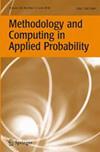一种新的基于Shannon熵的分离指标及分类技术
IF 1
4区 数学
Q3 STATISTICS & PROBABILITY
Methodology and Computing in Applied Probability
Pub Date : 2023-09-22
DOI:10.1007/s11009-023-10055-w
引用次数: 0
摘要
摘要目的是利用香农熵测度来发展分类技术和估计有限混合模型中群体分离的指标。这些度量可以应用于机器学习技术,如判别分析、聚类分析、探索性数据分析等。如果我们知道组的数量,并且我们有来自每个组的训练样本(监督学习),则该指标用于度量组的分离。这里使用一些熵度量来对这些组中的新个体进行分类。如果我们不确定组的数量(无监督学习),该指标可用于从熵(信息/不确定性)标准确定最优组的数量。它还可以用于确定最佳变量,以便将组分开。在所有情况下,我们假设我们有绝对连续的随机变量,我们使用基于概率密度函数的香农熵。在实践中,提出了理论、参数和非参数技术来获得这些熵测度的近似。本文还提供了一种在具有大量变量的结肠癌鉴别研究中进行基因选择的应用。本文章由计算机程序翻译,如有差异,请以英文原文为准。

A New Separation Index and Classification Techniques Based on Shannon Entropy
Abstract The purpose is to use Shannon entropy measures to develop classification techniques and an index which estimates the separation of the groups in a finite mixture model. These measures can be applied to machine learning techniques such as discriminant analysis, cluster analysis, exploratory data analysis, etc. If we know the number of groups and we have training samples from each group (supervised learning) the index is used to measure the separation of the groups. Here some entropy measures are used to classify new individuals in one of these groups. If we are not sure about the number of groups (unsupervised learning), the index can be used to determine the optimal number of groups from an entropy (information/uncertainty) criterion. It can also be used to determine the best variables in order to separate the groups. In all the cases we assume that we have absolutely continuous random variables and we use the Shannon entropy based on the probability density function. Theoretical, parametric and non-parametric techniques are proposed to get approximations of these entropy measures in practice. An application to gene selection in a colon cancer discrimination study with a lot of variables is provided as well.
求助全文
通过发布文献求助,成功后即可免费获取论文全文。
去求助
来源期刊
CiteScore
1.70
自引率
0.00%
发文量
58
审稿时长
6-12 weeks
期刊介绍:
Methodology and Computing in Applied Probability will publish high quality research and review articles in the areas of applied probability that emphasize methodology and computing. Of special interest are articles in important areas of applications that include detailed case studies. Applied probability is a broad research area that is of interest to many scientists in diverse disciplines including: anthropology, biology, communication theory, economics, epidemiology, finance, linguistics, meteorology, operations research, psychology, quality control, reliability theory, sociology and statistics.
The following alphabetical listing of topics of interest to the journal is not intended to be exclusive but to demonstrate the editorial policy of attracting papers which represent a broad range of interests:
-Algorithms-
Approximations-
Asymptotic Approximations & Expansions-
Combinatorial & Geometric Probability-
Communication Networks-
Extreme Value Theory-
Finance-
Image Analysis-
Inequalities-
Information Theory-
Mathematical Physics-
Molecular Biology-
Monte Carlo Methods-
Order Statistics-
Queuing Theory-
Reliability Theory-
Stochastic Processes

 求助内容:
求助内容: 应助结果提醒方式:
应助结果提醒方式:


